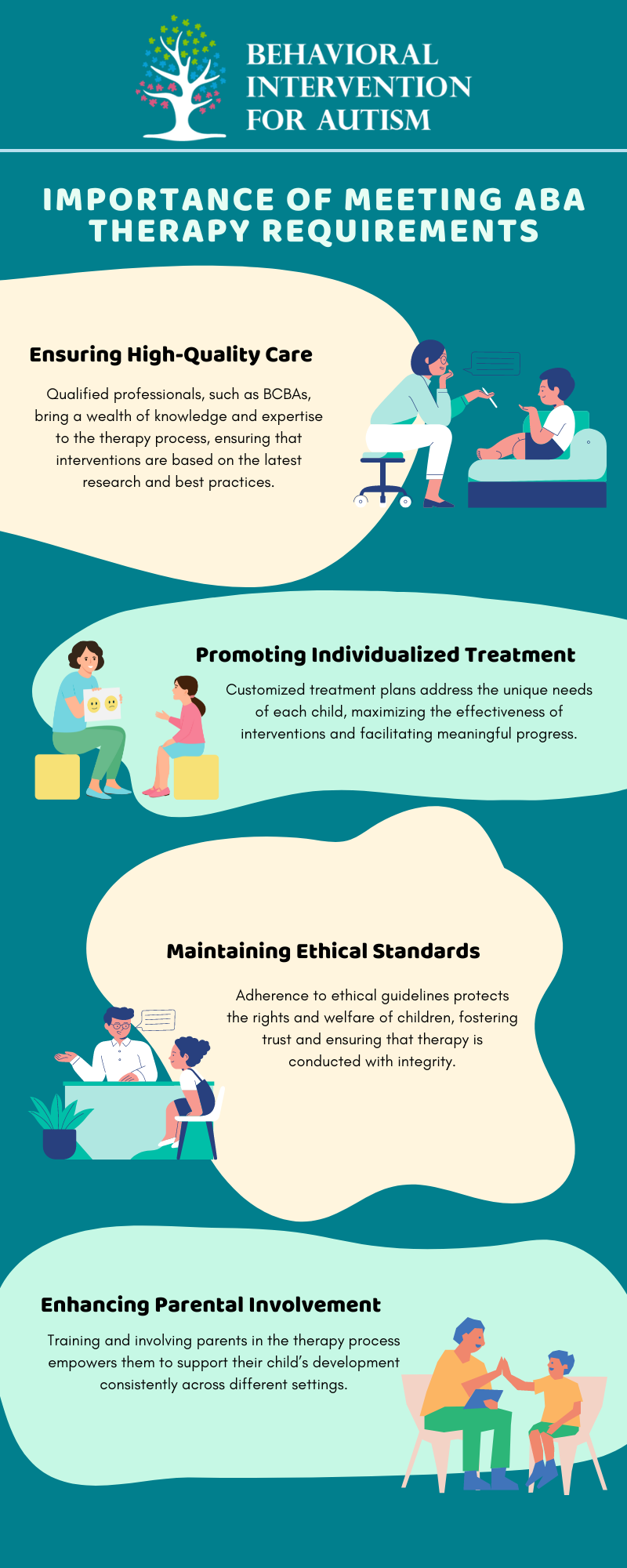
Table of Contents
Applied Behavior Analysis (ABA) therapy is a widely recognized approach for treating individuals with Autism Spectrum Disorder (ASD) and other developmental conditions. ABA therapy focuses on modifying behaviors to improve social, communication, and learning skills. However, to ensure the effectiveness and integrity of ABA therapy, certain requirements and standards must be met. This article provides a comprehensive list of ABA therapy requirements, followed by supplementary information on their importance, implementation, and how parents can ensure their chosen providers meet these criteria.
ABA Therapy Requirements
Here is a list of the requirements to consider when looking for an ABA Therapy provider or therapist:
1. Board Certified Behavior Analysts (BCBAs)
BCBAs are professionals certified by the Behavior Analyst Certification Board (BACB). They possess the necessary training, expertise, and credentials to design and oversee ABA therapy programs. To become a BCBA, one must obtain a graduate degree in behavior analysis or a related field, complete supervised practical experience, and pass the BCBA certification exam.
2. Individualized Treatment Plans
Each child’s treatment plan must be customized to address their unique strengths, weaknesses, and needs. This process involves comprehensive assessments to identify target behaviors, setting specific, measurable, and achievable goals, and regularly updating the treatment plan based on progress and changing needs.
3. Functional Behavior Assessments (FBAs)
FBAs are essential for understanding the reasons behind certain behaviors. They involve direct observation of the child in various settings, interviews with parents, teachers, and caregivers, and data collection and analysis to identify patterns and triggers.
4. Evidence-Based Interventions
ABA therapy should employ interventions supported by empirical research. Common evidence-based interventions include Discrete Trial Training (DTT), Natural Environment Teaching (NET), Pivotal Response Training (PRT), and Verbal Behavior (VB) therapy.
5. Data Collection and Analysis
Continuous data collection is critical for monitoring the child’s progress and making necessary adjustments to the treatment plan. This involves recording data on target behaviors, analyzing data to identify trends and the effectiveness of interventions, and using data to inform decision-making and ensure the treatment remains effective.
6. Parental Involvement and Training
Parents play a crucial role in the success of ABA therapy. This involves involving parents in the development and implementation of the treatment plan, providing training to parents so they can reinforce skills and strategies at home, and maintaining regular communication between therapists and parents to discuss progress and challenges.
7. Ethical Standards
Adherence to ethical standards is paramount in ABA therapy. The BACB provides a code of ethics that BCBAs and other professionals must follow, which includes prioritizing the welfare and rights of the child, obtaining informed consent from parents or guardians, ensuring confidentiality and privacy of the child’s information, and avoiding conflicts of interest.
8. Supervision and Ongoing Professional Development
ABA therapists must receive regular supervision and engage in ongoing professional development to maintain their skills and knowledge. This includes supervision by a BCBA or a senior behavior analyst, participating in continuing education and training programs, and staying updated with the latest research and best practices in ABA therapy.
How Would You Know if the ABA Therapy Requirements Are Met?
Implementing ABA therapy requires careful planning and collaboration among therapists, parents, educators, and other professionals. Here are some indicators that ABA therapists are implementing the requirements needed in the procedure well:
Developing and Updating Treatment Plans
Developing and updating treatment plans involves conducting thorough initial assessments to gather comprehensive information about the child’s behavior and needs. Then, collaborate with parents and other stakeholders to set realistic goals, schedule regular reviews to assess the child’s progress, and update the treatment plan as needed.
Conducting Functional Behavior Assessments
Conduct functional behavior assessments (FBAs) by observing the child in different environments to gather data on their behavior, which is followed by interviews with parents, teachers, and caregivers to gain insights into the child’s behavior and possible triggers. Then, analyzing the data to identify patterns and develop targeted interventions.
Ensuring Evidence-Based Interventions
Ensure evidence-based interventions by staying informed about the latest research and developments in ABA therapy. Attend workshops, seminars, and other training programs to learn about new evidence-based interventions, and engage with other professionals to share knowledge and experiences regarding effective interventions.
Collecting and Analyzing Data
Collect and analyze data by establishing a systematic process for recording data on target behaviors while using software or other tools to organize and analyze the data, and regularly review the data to assess the effectiveness of interventions and make necessary adjustments to the treatment plan.
Involving and Training Parents
Involve and train parents by scheduling regular meetings to discuss their child’s progress and address any concerns. Ideally, they’d also provide training sessions to equip parents with the skills and strategies needed to support their child’s development at home while encouraging them to join support groups or networks to share experiences and gain additional support.
Adhering to Ethical Standards
Adhere to ethical standards by ensuring that all professionals involved in the therapy process receive training on ethical guidelines, and obtain informed consent from parents or guardians before starting any interventions. Lastly, they implement strict protocols to protect the confidentiality and privacy of the child’s information.
Supervision and Professional Development
Supervision and professional development are crucial for maintaining high standards in ABA therapy. If they schedule regular supervision sessions to review the therapist’s work and provide guidance and feedback, then they’re following the requirements. It’s a bonus if they also encourage other therapists to participate in continuing education programs to stay updated with the latest research and best practices, and join professional organizations or networks to engage with peers and stay informed about developments in the field.
By implementing these comprehensive strategies, stakeholders can ensure the highest standards of care in ABA therapy, fostering positive outcomes for children with ASD and other developmental conditions.
Importance of Meeting ABA Therapy Requirements
Meeting these requirements ensures that ABA therapy is delivered effectively and ethically, providing the best possible outcomes for children with ASD. Here are some key reasons why these requirements are crucial:
Conclusion
Meeting the requirements for ABA therapy is essential for providing high-quality, effective, and ethical services to children with ASD and other developmental conditions. By ensuring that qualified professionals are involved, individualized treatment plans are developed, and evidence-based interventions are used, parents can be confident in the positive impact of ABA therapy on their child’s development.
Regular data collection and analysis, parental involvement, adherence to ethical standards, and ongoing professional development are key components of a successful ABA therapy program. Through diligent implementation and continuous quality assurance, ABA therapy can significantly improve the lives of children and their families.
If you’re interested in our ABA programs in Florida, Behavioral Intervention for Autism offers expert services tailored to meet your child’s unique needs. Contact us today to learn more about our services.
Sources:
https://special-learning.com/qualifications-of-an-ideal-aba-therapist/#
https://www.iloveaba.com/2011/08/what-does-great-aba-therapist-look-like.html
https://www.indeed.com/career-advice/career-development/how-to-become-aba-therapist
- 9 Common Obsessions of Children With Autism You Should Know - February 25, 2025
- What is Neurodiversity? A Guide to Embracing Differences - February 25, 2025
- Understanding Hyperfocus in Autism: What It Means and Why It Happens - February 25, 2025



